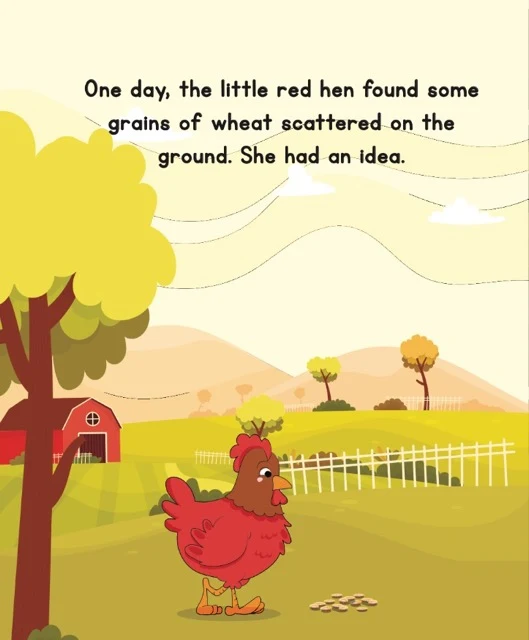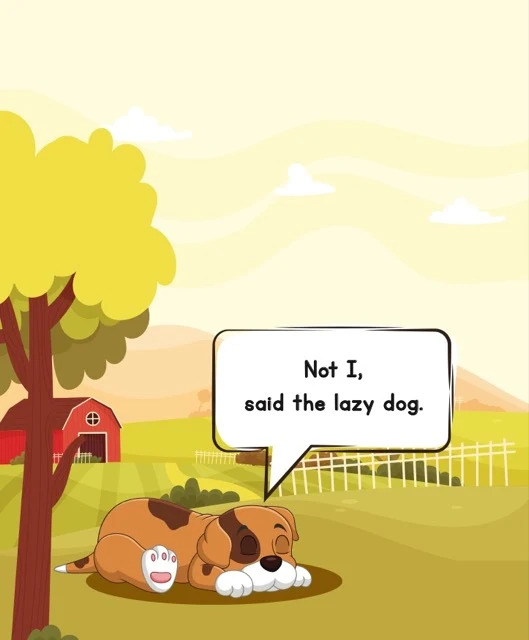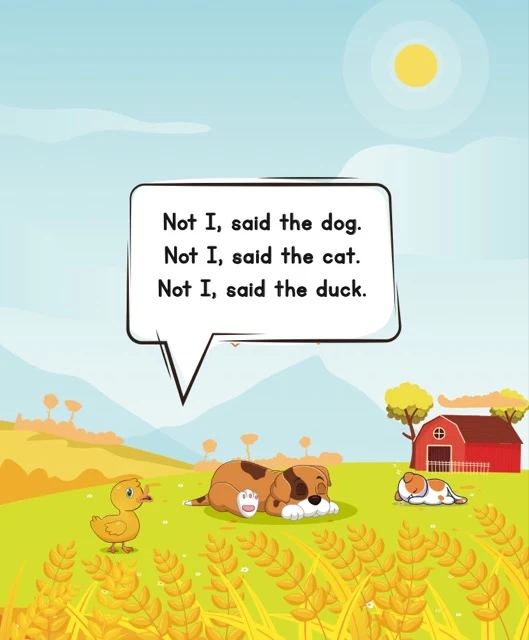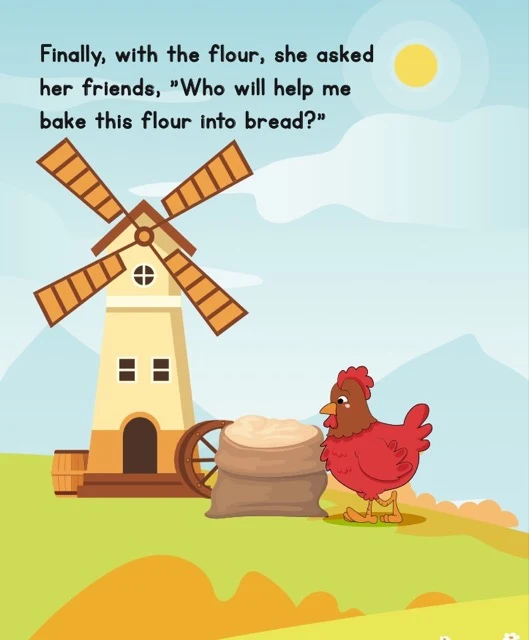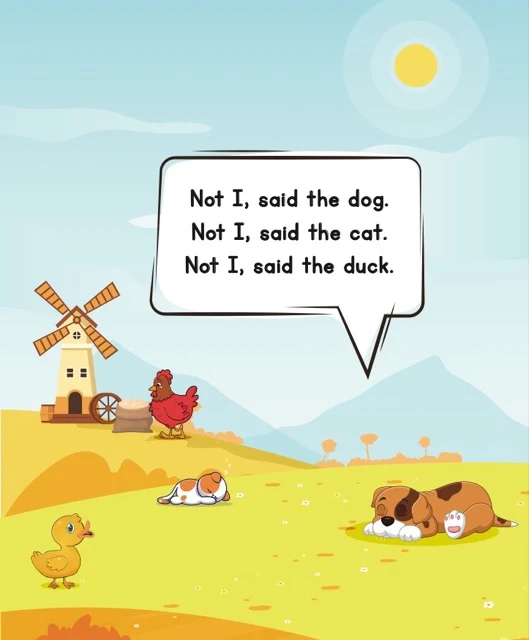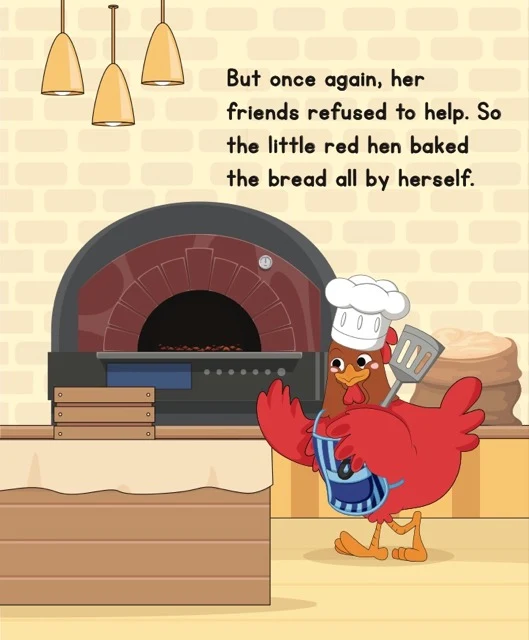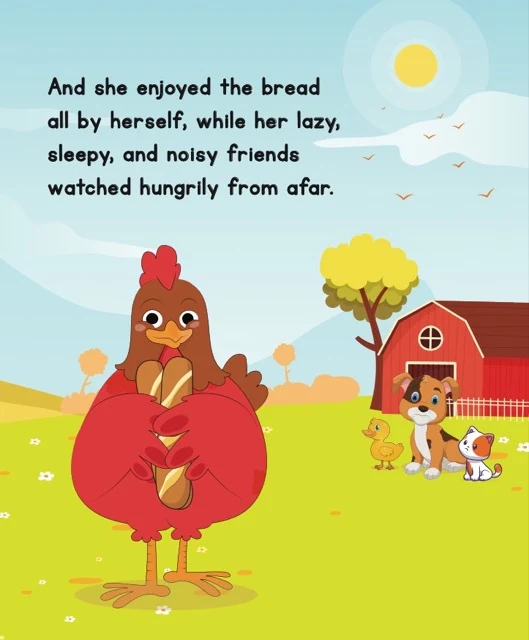The Little Red Hen: A Multifaceted Analysis
These sources offer a multifaceted analysis of the children's story "The Little Red Hen," exploring its central themes of hard work versus laziness, self-reliance, and fairness. They examine the story's moral ambiguities, prompting discussion about the Little Red Hen's actions and the motivations of the other animals. The sources also consider the story's contemporary relevance, suggesting its applicability to teaching children about teamwork, collaboration, and the connection between effort and reward. Finally, they provide various pedagogical tools, including visual aids, quizzes, and essay questions, for understanding and teaching the story's enduring message.
The Little Red Hen: Themes and Interpretations
Briefing Document: Exploring Themes and Ideas in "The Little Red Hen"
Sources:
●
Excerpts from "Testing Theme: The Little Red Hen.pdf" (Visual retelling)
●
Excerpts from "The Little Red Hen: A Closer Look" (FAQ and discussion points)
●
Excerpts from "Understanding 'The Little Red Hen'" (Quiz, essay questions, and glossary)
Main Themes:
●
Hard work and its rewards: This is the most prominent theme, highlighted by the Little Red Hen's dedication and the lazy animals' lack of reward. As "The Little Red Hen: A Closer Look" states, the story "teaches the importance of hard work and the value of contributing to a shared goal."
●
Consequences of laziness: The story contrasts the Little Red Hen's self-sufficiency with the animals' reliance on others. It demonstrates that those who shirk effort may miss out on the benefits.
●
Self-reliance and independence: The Little Red Hen embodies self-reliance by completing the task alone. This is highlighted in the "Understanding 'The Little Red Hen'" section, which states she demonstrates "self-reliance by completing the task without depending on others."
●
Fairness and sharing: The story sparks debate about whether the Little Red Hen is justified in not sharing. This moral ambiguity is acknowledged in "The Little Red Hen: A Closer Look," stating, "Some might argue that she should share, while others believe she is justified in keeping the bread for herself since she did all the work."
Important Ideas and Facts:
●
The Little Red Hen finds wheat and wants to bake bread.
●
She asks the cat, dog, and pig for help, but they refuse, offering excuses like "I am too sleepy." (Visual retelling)
●
The Little Red Hen completes all the work herself: planting, harvesting, grinding, and baking.
●
When the bread is ready, the animals want to eat it, but the Little Red Hen refuses to share.
●
The ending teaches that those who don't contribute shouldn't expect to benefit. "The Little Red Hen responds to her friends' requests for bread [by] refusing to share the bread, telling them that since they didn’t help with the work, they won’t get to enjoy the reward." ("The Little Red Hen: A Closer Look")
●
The story can be interpreted from different perspectives: focusing on the virtue of hard work or questioning the fairness of the Little Red Hen's actions.
●
Modern interpretations could adapt the story to address contemporary issues like teamwork, collaboration, and group dynamics.
Discussion Points:
●
Is the Little Red Hen's refusal to share justified? Does it teach a valuable lesson or a harsh one?
●
What are the possible motivations for the other animals' laziness? Are they simply lazy or could there be other factors?
●
How can the story be used to teach children about teamwork and collaboration? Could the Little Red Hen have encouraged participation differently?
●
How relevant is the story's message in today's society?
Relevance to Contemporary Society:
While seemingly simple, "The Little Red Hen" offers valuable insights into universal themes like work ethic, responsibility, and fairness. It can be used to:
●
Encourage children to understand the relationship between effort and reward.
●
Spark discussions about the importance of contributing to group efforts.
●
Explore the complexities of sharing and fairness in different situations.
●
Foster a sense of self-reliance and independence.
Conclusion:
"The Little Red Hen" is a timeless tale that continues to resonate with readers of all ages. By examining its themes and engaging in thoughtful discussion, we can extract valuable lessons about hard work, responsibility, and the consequences of our choices.
The Little Red Hen: A Closer Look
The Little Red Hen: FAQ
1. What is the main problem the Little Red Hen faces?
The Little Red Hen finds some wheat and wants to make bread. However, none of her friends—the cat, the dog, or the pig—are willing to help her with any of the work.
2. How does the Little Red Hen solve her problem?
The Little Red Hen decides to do all the work herself. She plants the wheat, harvests it, grinds it into flour, makes the dough, and bakes the bread, all without any help from her lazy friends.
3. What do the cat, the dog, and the pig do while the Little Red Hen works?
They refuse to help with any of the tasks, preferring to sleep or play instead.
4. What happens when the bread is finally ready?
The cat, the dog, and the pig all want to eat the bread, even though they refused to help make it.
5. How does the Little Red Hen respond to her friends' requests for bread?
She refuses to share the bread, telling them that since they didn’t help with the work, they won’t get to enjoy the reward.
6. What is the main lesson of the story?
The story teaches the importance of hard work and the value of contributing to a shared goal. It also demonstrates the consequences of laziness and the idea that you don't deserve to reap the benefits if you haven't shared in the effort.
7. Is the Little Red Hen being unfair by not sharing the bread?
This is a point for discussion. Some might argue that she should share, while others believe she is justified in keeping the bread for herself since she did all the work.
8. How is the story relevant to children today?
The themes of hard work, responsibility, and the value of contributing to a group effort are timeless and applicable to children in any era. The story can spark conversations about the importance of helping others, being self-reliant, and understanding the relationship between effort and reward.
Understanding "The Little Red Hen"
Exploring the Lessons of "The Little Red Hen"
Short-Answer Quiz
1.
What is the initial task that the Little Red Hen wants to accomplish?
2.
Describe the responses of the cat, the dog, and the pig when the Little Red Hen asks for help.
3.
How does the Little Red Hen approach the work that needs to be done?
4.
What changes in the animals' attitudes occur once the bread is baked?
5.
How does the Little Red Hen respond to the animals' requests for bread?
6.
What are two possible themes explored in "The Little Red Hen"?
7.
Is there a character in the story who could be considered an antagonist? Explain your reasoning.
8.
Why might some readers feel sympathy for the cat, the dog, and the pig?
9.
What might be a real-life situation where the lesson of "The Little Red Hen" could be applied?
10.
Beyond hard work, what other character trait does the Little Red Hen demonstrate?
Answer Key
1.
The Little Red Hen finds some wheat and wants to bake it into bread.
2.
The cat, the dog, and the pig all refuse to help, each offering an excuse or simply saying "Not I."
3.
The Little Red Hen completes all the steps of planting, harvesting, grinding, and baking the bread by herself.
4.
The animals become eager to eat the bread, despite their prior unwillingness to help.
5.
The Little Red Hen refuses to share the bread, stating that they did not help, so they will not share in the reward.
6.
Two possible themes are the importance of hard work and the consequences of laziness.
7.
The cat, the dog, and the pig could be considered antagonists as their laziness creates an obstacle for the Little Red Hen.
8.
Readers might sympathize with the animals because they may seem playful and harmless rather than intentionally malicious.
9.
A real-life situation could be a group project where some members do all the work while others avoid contributing.
10.
The Little Red Hen also demonstrates self-reliance by completing the task without depending on others.
Essay Questions
1.
Analyze the ending of "The Little Red Hen." Is the Little Red Hen justified in not sharing the bread? Consider the perspectives of both the Little Red Hen and the other animals.
2.
Explore the possible motivations behind the cat, the dog, and the pig's refusal to help. Are they simply lazy, or could there be other factors at play?
3.
Discuss how the story of "The Little Red Hen" can be used to teach children about the value of teamwork and collaboration. What are some alternative approaches the Little Red Hen could have taken to encourage participation?
4.
Compare and contrast the character of the Little Red Hen with one of the other animals. How do their personalities and actions differ?
5.
Imagine a modern-day retelling of "The Little Red Hen." How could the story be adapted to reflect contemporary issues and values?
Glossary of Key Terms
●
Theme: The central idea or message conveyed in a literary work.
●
Antagonist: A character who opposes or creates conflict for the protagonist.
●
Protagonist: The main character in a story, often the one facing challenges.
●
Motivation: The reasons behind a character's actions or behavior.
●
Self-Reliance: The ability to depend on oneself and one's own abilities.
●
Collaboration: Working together with others to achieve a common goal.
●
Consequences: The results or effects of an action or choice.
●
Perspective: A particular point of view or way of seeing things.
●
Adapt: To change or adjust something to suit a new purpose or situation.
●
Contemporary: Relating to the present time or current era.


